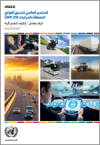Publications
Displaying Results 61 - 80 of 205
- Español
Al igual que las versiones anteriores, la cuarta edición del Libro azul ofrece información precisa acerca del Foro Mundial para la Armonización de la Reglamentación sobre Vehículos (WP.29) creado al amparo de la División de Transporte Sostenible de la CEPE, su historia, su marco administrativo y jurídico, como guía para los usuarios, y los tres Acuerdos.
El WP.29 administra los tres principales
- العربية
تواصل الطبعة الرابعة من الكتاب األزرق تقديم معلومات دقيقة عن المنتدى العالمي لتنسيق
اللوائح المتعلقة بالمركبات (WP.29) الذي تشرف عليه وحدة النقل المستدام، تتناول تاريخه، وإطاره اإلداري والقانوني
تكون بمثابة مرشد يستعين به المستخدمون، وتتعلق هذه المعلومات
أيضا ب االتفاقات الثالثة.
ويشرف المنتدى العالمي على اتفاقات األمم المتحدة الدولية الثالث بشأن المركبات اآللية وهي: اتفاق 1958،
واتفاق 1998
- Pусский
В четвертом издании Синей книги содержится точная информация о Всемирном форуме для согласования правил в области транспортных средств (WP.29), обслуживаемом Отделом устойчивого транспорта ЕЭК: о его истории, его административных и правовых рамках в качестве руководства для пользователей и о трех соглашениях.
В ведении WP.29 находятся три основных международных соглашения Организации
- English
The European Agreement concerning the International Carriage of Dangerous Goods by Inland Waterways (ADN) done at Geneva on 26 May 2000 under the auspices of the United Nations Economic Commission for Europe (UNECE) and the Central Commission for Navigation on the Rhine (CCNR) has been in force since February 2008. The Agreement currently has eighteen Contracting Parties. The Regulations
- English
Adopted on 30 September 1957 in Geneva under the auspices of the United Nations Economic Commission for Europe (UNECE), the ADR entered into force on 29 January 1968. This authoritative Agreement is intended to increase the safety of international transport of dangerous goods by road. Its Annexes A and B contain the technical requirements for road transport, i.e. the conditions under
- English
The present publication (download here) concerns intermodal transport, with a particular focus on the role of railways in intermodality and the importance of transport documents computerisation for intermodal transport. The publication is divided in three main parts: a first section discusses the intermodality and the role of
- English
ECE/TRANS/271, Sales No. E.17.VIII.2,ISBN 978-92-1-139160-2, Price: US$ 35, Languages: E, F, RThe Agreement on the International Carriage of Perishable Foodstuffs and on the Special Equipment to be Used for such Carriage (ATP) was done at Geneva on 1 September 1970 and entered into force on 21 November 1976. The objectives of
- English
The GHS addresses classification of chemicals by types of hazard and proposes harmonized hazard communication elements, including labels and safety data sheets. It aims at ensuring that information on physical hazards and toxicity from chemicals be available in order to enhance the protection of human health and the environment during the handling, transport and use of these chemicals.The GHS
- English
These recommendations have been developed in the light of technical progress, the advent of new substances and materials, the exigencies of modern transport systems and, above all, the requirement to ensure the safety of people, property and the environment. They are addressed to governments and international organisations concerned with the regulation of the transport of dangerous goods. The
- English
The European Agreement concerning the International Carriage of Dangerous Goods by Inland Waterways (ADN) done at Geneva on 26 May 2000 under the auspices of the United Nations Economic Commission for Europe (UNECE) and the Central Commission for Navigation on the Rhine (CCNR) has been in force since February 2008. The Agreement currently has eighteen Contracting Parties.The Regulations
- English
Adopted on 30 September 1957 in Geneva under the auspices of the United Nations Economic Commission for Europe (UNECE), the ADR entered into force on 29 January 1968.This authoritative Agreement is intended to increase the safety of international transport of dangerous goods by road. Its Annexes A and B contain the technical requirements for road transport, i.e. the conditions under which
- English
The United Nations Motorcycle Helmet StudyPart of WP.29, “How it works and how to join it”, series
- English
Child Restraint systemsUN Regulation No 129: Increasing the safety of children in vehicles - For policymakers and concerned citizens.
- English
ST/SG/AC.10/11/Rev.6Sales No. E.15.VIII.3ISBN 978-92-1-139155-8Price: US$ 125Languages: E, F, S (A, C, R forthcoming)How to order this publication?This publication is also available online for free (download).The Manual of Tests and Criteria contains criteria, test methods and procedures to be used for classification of
- English
ECE/TRANS/249, Sales No. E.15.VIII.2,ISBN 978-92-1-139153-3, Price: US$ 35, Languages: E, F, RThe Agreement on the International Carriage of Perishable Foodstuffs and on the Special Equipment to be Used for such Carriage (ATP) was done at Geneva on 1 September 1970 and entered into force on 21 November 1976. The objectives of
- English
Download in PDF or e-Pub format (smartphones)The publication titled "Transport for Sustainable Development: The case of Inland Transport” is the result of the cooperation among the five
- English
The GHS addresses classification of chemicals by types of hazard and proposes harmonized hazard communication elements, including labels and safety data sheets. It aims at ensuring that information on physical hazards and toxicity from chemicals be available in order to enhance the protection of human health and the environment during the handling, transport and use of these chemicals.The GHS
- English
These recommendations have been developed in the light of technical progress, the advent of new substances and materials, the exigencies of modern transport systems and, above all, the requirement to ensure the safety of people, property and the environment. They are addressed to governments and international organisations concerned with the regulation of the transport of dangerous goods. The
- English
The European Agreement concerning the International Carriage of Dangerous Goods by Inland Waterways (ADN) done at Geneva on 26 May 2000 under the auspices of the United Nations Economic Commission for Europe (UNECE) and the Central Commission for Navigation on the Rhine (CCNR) has been in force since February 2008. The Agreement currently has eighteen Contracting Parties.The Regulations
- English
Adopted on 30 September 1957 in Geneva under the auspices of the United Nations Economic Commission for Europe (UNECE), the ADR entered into force on 29 January 1968. This authoritative Agreement is intended to increase the safety of international transport of dangerous goods by road. Its Annexes A and B contain the technical requirements for road transport, i.e. the conditions under





















